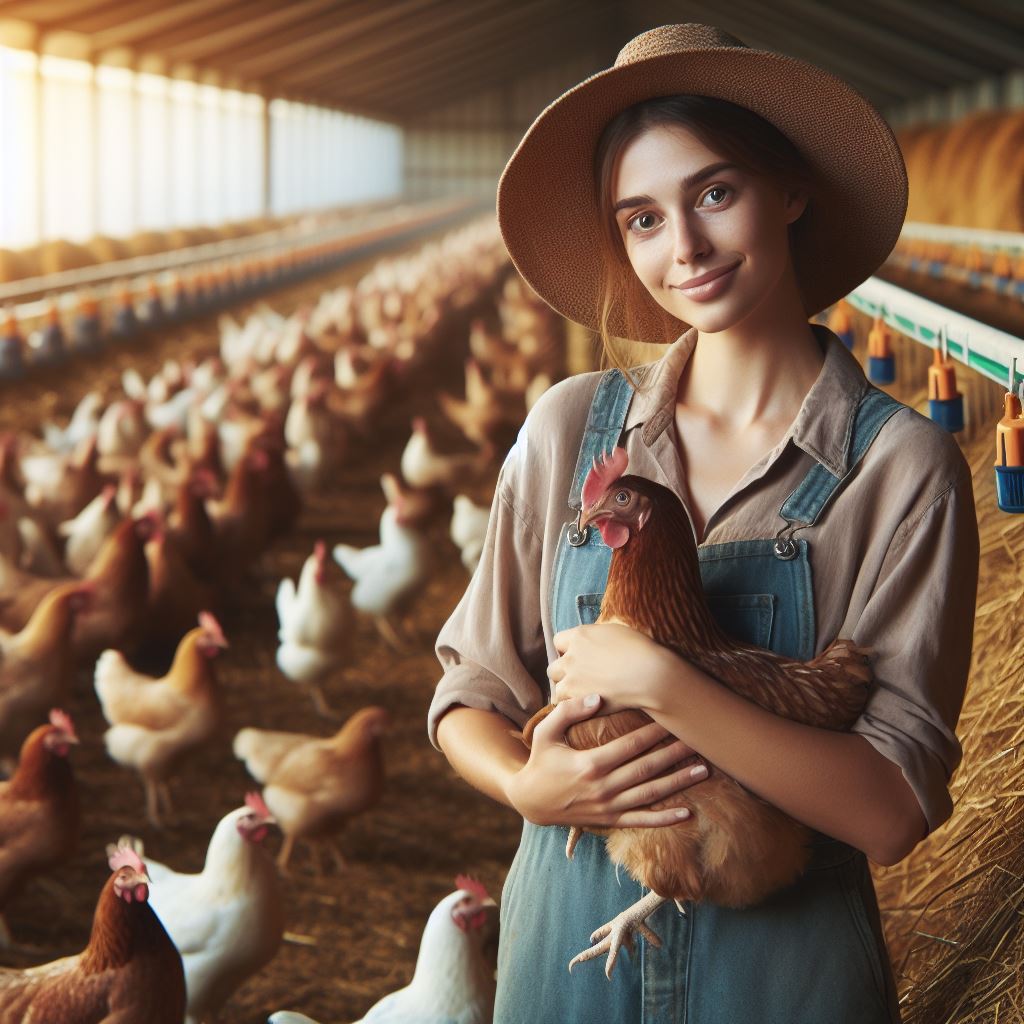Introduction
Urban farming refers to the practice of growing food in urban areas to promote sustainability and local food production.
It is an innovative solution to address food insecurity and promote healthier eating habits.
However, urban farming faces several challenges that need to be addressed to ensure its success and impact.
By addressing the challenges in urban farming, we can create a more sustainable and resilient food system in cities.
Urban farming can contribute to food security, reduce the carbon footprint of food production and transportation, and promote healthier and fresher food options.
In this blog section, we will discuss some of the key challenges in urban farming and explore potential solutions.
First, we will delve into the issue of space availability in urban areas, where land is limited and often expensive.
Second, we will address the challenge of soil quality and contamination, as urban soils may be polluted with chemicals and heavy metals.
Third, we will examine the issue of limited access to resources such as water and energy, which are essential for successful urban farming.
Finally, we will explore the challenge of community engagement and education, as urban farming requires active participation and support from local residents.
By understanding and finding solutions to these challenges, we can unlock the full potential of urban farming and create a more sustainable and resilient food system in cities.
Join us in the following section as we dive deeper into each of these challenges and discuss innovative approaches and best practices.
Limited Space
The scarcity of land in urban areas
- Urban areas face a significant challenge when it comes to the availability of land.
- The growing population and increasing urbanization have led to the scarcity of land for traditional farming.
- With limited space, the need for alternative farming methods becomes crucial to ensure food production.
Tips and strategies for maximizing small spaces
- Make use of rooftops, balconies, and windowsills to create small gardens.
- Container gardening is an excellent option for maximizing space, using pots, buckets, or vertical planters.
- Utilize walls and fences by growing plants vertically, saving horizontal space.
- Opt for compact plant varieties that require less space but still provide a good yield.
- Utilize hanging baskets or wall pockets to grow herbs and vegetables.
Introduction to vertical gardening techniques
- Vertical gardening involves growing plants in a vertical space, such as walls or trellises.
- This technique maximizes limited space while offering a visually appealing garden.
- One popular method is using a trellis system, where plants grow vertically with support.
- Another technique is hydroponics, growing plants in a nutrient-rich water solution without soil.
- Green walls or living walls are vertical structures covered with plants, purifying the air and providing insulation.
Benefits of maximizing small spaces
- Ensures food production in urban areas.
- Increases self-sufficiency and reduces dependence on external food sources.
- Improves air quality and provides a greener environment.
- Creates a sense of community and promotes a healthy lifestyle.
Advantages of vertical gardening
- Maximizes limited space, making it ideal for urban farming.
- Allows gardening in areas with limited access to soil.
- Provides better air circulation and sunlight exposure for plants.
- Can be aesthetically pleasing, enhancing the visual appeal of urban areas.
Challenges of urban farming in limited space
- Limited access to sunlight due to surrounding buildings.
- Risk of water runoff and inadequate drainage.
- Maintaining a consistent temperature, especially in urban heat islands.
- Limited availability of resources and higher costs for urban farming equipment and tools.
Creative ideas for small-space urban farming
- Herb and salad gardens in window boxes or hanging baskets.
- Utilizing vertical hydroponic systems for growing leafy greens.
- Creating a vertical strawberry garden using PVC pipes attached to walls.
- Constructing a garden on a rooftop or balcony using raised beds or containers.
- Using a living wall system to grow a variety of plants vertically.
By effectively utilizing limited space and exploring vertical gardening techniques, urban farming can overcome the challenges of land scarcity.
Maximizing small spaces not only ensures food production but also promotes a greener and healthier environment in our cities.
Read: ATL’s Urban Farm Dream: One Farmer’s Journey
Soil Quality
Urban soil pollution and contamination
Urban soil pollution and contamination are significant challenges in urban farming.
Due to industrial activities, vehicle emissions, and improper waste disposal, urban soils often contain high levels of heavy metals, pesticides, and other harmful chemicals.
These pollutants can have detrimental effects on plant growth and health.
Heavy metals such as lead, arsenic, and cadmium can accumulate in plants and pose serious health risks to consumers.
Pesticides can also contaminate crops, leading to potential harm to both humans and the environment.
Importance of testing soil before farming
Testing soil before farming is crucial for urban farmers to understand its quality and potential risks.
Soil testing provides valuable information on nutrient content, pH level, and the presence of contaminants.
By testing the soil, farmers can determine the appropriate amendments and treatments needed to optimize soil health for plant growth.
It also helps in identifying contaminated areas that may require remediation or avoidance to ensure food safety.
Suggestions for improving soil health in urban settings
Remediation and soil restoration programs
Collaborate with local authorities to implement soil remediation programs to minimize soil contamination.
Such programs can involve controlling industrial emissions and promoting proper waste management.
Use of organic amendments
Incorporate organic amendments like compost, manure, and cover crops to boost soil fertility and structure.
These organic materials enhance nutrient retention and microbial activity, promoting overall soil health.
Crop rotation and diversification
Adopt crop rotation practices to prevent nutrient depletion and disease buildup in the soil.
Grow a variety of crops to enhance soil biodiversity and improve its resilience to pests and diseases.
Rainwater harvesting and irrigation management
Develop systems for rainwater harvesting and efficient irrigation practices to conserve water resources.
Overwatering can contribute to soil erosion and leach nutrients, endangering soil health.
Contaminated soil avoidance
Identify and avoid farming in areas with a high risk of soil contamination, such as former industrial sites or near busy highways.
This minimizes the risk of contaminants entering the food chain.
Transform Your Agribusiness
Unlock your farm's potential with expert advice tailored to your needs. Get actionable steps that drive real results.
Get StartedPromote soil education and awareness
Educate urban farmers and residents about soil health, pollution prevention, and sustainable farming practices.
Raise awareness about the importance of soil testing and proper soil management techniques.
Community gardens and urban green spaces
Encourage the establishment of community gardens and urban green spaces, which can serve as alternatives for farming in contaminated areas.
These spaces can provide opportunities for organic farming and community engagement.
Support local initiatives and organizations
Collaborate with local initiatives and organizations focused on sustainable urban farming practices.
By supporting and participating in these initiatives, farmers can learn from experienced professionals and access necessary resources.
By addressing the challenges of urban soil pollution and contamination, urban farmers can create healthy and sustainable farming environments.
Through proactive measures and community involvement, urban farming can thrive and contribute to a more resilient and food-secure future.
Read: Sowing Success: Inspirational Female Farmer Stories

Access to Resources
Lack of access to agricultural inputs in cities
In urban farming, one of the major challenges faced is the limited access to essential agricultural inputs.
In traditional farming, farmers have easy access to fertile land, irrigation systems, seeds, and fertilizers.
However, in cities, the availability of such resources becomes scarce.
Urban areas are predominantly covered with concrete jungles, leaving little or no space for traditional farming practices.
This lack of open land prevents urban farmers from utilizing the most basic resource required for agriculture – soil.
Without fertile soil, it becomes challenging to grow crops and produce a substantial yield.
Moreover, the scarcity of land also restricts the use of heavy machinery and equipment essential for farming.
Farmers in urban settings must rely on manual labor and small-scale tools.
This limitation hampers the efficiency and productivity of urban farming.
The importance of water and light sources
Apart from restricted access to land, urban farmers also face challenges in acquiring two crucial resources – water and light.
Water is an irreplaceable component for plant growth, and without an adequate supply, urban farming becomes a formidable task.
In cities, municipal water supply systems may not be designed to cater to the water needs of urban farms.
As a result, farmers have to rely on alternate and sustainable water sources, such as rainwater harvesting and wastewater recycling.
These methods, although effective, require additional infrastructure and investments.
Similarly, light sources play a vital role in the growth and development of plants.
Natural sunlight is limited in urban areas due to the presence of tall buildings and shaded spaces.
Consequently, artificial lighting systems, such as Grow Lights, are crucial for indoor farming.
Incorporating these lights increases energy consumption and adds to the challenges of urban farming.
Introduction to alternative resources, such as hydroponics and aquaponics
To overcome the challenges of limited access to traditional resources, urban farmers have turned to alternative farming techniques, such as hydroponics and aquaponics.
These methods offer innovative solutions for urban agriculture.
Hydroponics is a soil-less farming technique that uses water enriched with essential nutrients to grow plants.
It requires smaller space compared to traditional farming and can be practiced indoors.
The efficient use of water in hydroponics reduces the dependency on land and irrigation systems.
Aquaponics takes the concept of hydroponics a step further by integrating fish farming with plant cultivation.
Fish waste provides valuable nutrients to the plants, while the plants filter the water for the fish.
This symbiotic relationship creates a sustainable and resource-efficient farming system.
Both hydroponics and aquaponics address the challenges of limited land availability, water scarcity, and reliance on traditional resources.
These methods promote urban farming in areas where conventional agriculture would be impractical.
In general, accessing essential resources is a significant challenge in urban farming.
The lack of agricultural inputs, such as land and machinery, hinders the productivity of urban farmers.
Moreover, limited access to water and light sources further adds to the difficulties.
However, alternative farming techniques like hydroponics and aquaponics provide innovative solutions to overcome these challenges.
By embracing these methods, urban farmers can optimize their resources and contribute to sustainable food production in cities.
Read: Philly’s Foodscapes: Urban Farming Upsurge
Zoning and Regulations
Overview of zoning laws in urban areas
- Zoning laws regulate land use in urban areas.
- They determine what can be built and where.
- They affect where urban farmers can grow their crops.
- Zoning laws can be strict and limit agricultural activities.
Challenges faced by urban farmers due to restrictive regulations
- Some zoning laws don’t recognize urban farming as a legitimate land use.
- Existing regulations often favor traditional residential and commercial development.
- These regulations can restrict the size and types of gardens and farm animals allowed.
- Many urban farmers face obstacles in obtaining permits and meeting zoning requirements.
Advocacy for reevaluating zoning and regulations to support urban farming
- Efforts are underway to advocate for changes in zoning laws to support urban farming.
- Advocates seek to create new zoning categories specifically for urban agriculture.
- They aim to relax restrictions on farming activities in urban areas.
- By reevaluating regulations, urban farming could flourish and benefit communities.
Read: Detroit’s Green Makeover: Urban Farm Success
Community Engagement
Importance of creating a network of urban farmers
Engaging the local community in urban farming is crucial for the success and sustainability of these projects.
By building a network of urban farmers, we can create a support system that fosters knowledge sharing and collaboration.
Through community engagement, urban farmers can learn from each other’s experiences, exchange ideas, and face challenges together.
This network can also help in pooling resources, sharing tools, and improving access to markets.
Creating a community of urban farmers not only benefits individuals, but it also enhances the resilience and productivity of urban farming as a whole.
It allows for the formation of a strong voice that can advocate for urban agriculture and its many benefits.
Ways to connect with local communities and share resources
- Organize workshops and training sessions: Hosting workshops and training sessions on urban farming can attract community members interested in learning about sustainable food production. This provides an opportunity to connect with like-minded individuals and share resources.
- Participate in local events: Getting involved in community events, such as farmers’ markets or food festivals, not only allows urban farmers to showcase their produce but also fosters connections with consumers who appreciate locally grown food.
- Collaborate with schools and educational institutions: Working with schools and educational institutions can offer opportunities to educate students about urban farming techniques and the importance of sustainable agriculture. This collaboration can result in shared resources, such as land or knowledge.
- Engage with local businesses: Partnering with local businesses, such as restaurants or grocery stores, can create a direct market for urban farmers’ produce. This collaboration can also lead to resource sharing, such as composting or waste management.
- Utilize social media and online platforms: Leveraging social media channels and online platforms focused on urban farming allows farmers to connect with a wider audience and share information, resources, and success stories.
Examples of successful community-engaged urban farming projects
- The Brooklyn Grange Rooftop Farms in New York City: This project engages the local community by offering workshops, educational programs, and volunteer opportunities. It creates a space for people to connect, learn, and actively participate in urban agriculture.
- The Growing Power project in Milwaukee: This non-profit organization has successfully engaged the local community by transforming abandoned warehouses into productive urban farms. They provide training, employment opportunities, and fresh produce to the community.
- The Detroit Black Community Food Security Network: This organization focuses on community empowerment through urban farming. They run various programs and initiatives that educate and empower Detroit residents to grow their own food and build sustainable food systems.
- The Green City Growers Cooperative in Cleveland: This cooperative engages communities by turning vacant lots into urban farms. They collaborate with local residents, providing employment and fresh, affordable produce to neighborhoods lacking access to healthy foods.
By highlighting these successful community-engaged urban farming projects, we can inspire others to create similar initiatives and strengthen the network of urban farmers.
Engaging local communities and creating networks of urban farmers is crucial to the success of urban farming projects.
By connecting, sharing resources, and learning from one another, we can build resilient, sustainable, and inclusive food systems in our cities.
Uncover the Details: Small Farm, Big Yield: Secrets Unveiled
Showcase Your Farming Business
Publish your professional farming services profile on our blog for a one-time fee of $200 and reach a dedicated audience of farmers and agribusiness owners.
Publish Your ProfileConclusion
Recap of the challenges discussed
In this section, we have explored the challenges faced by urban farmers in the city.
We have seen that limited space, soil quality, and access to resources pose significant obstacles.
Additionally, issues of zoning and regulations often hinder the growth of urban farming initiatives.
Encouragement for urban farmers to persevere and find innovative solutions
Despite these challenges, urban farmers should not lose hope.
Innovation and creativity have always been at the heart of agriculture, and urban farming is no exception.
By embracing vertical farming, hydroponics, and community partnerships, urban farmers can overcome limitations and thrive in the city.
Call to action for readers to support urban farming initiatives in their communities
The importance of urban farming cannot be overstated.
It promotes sustainable agriculture, provides fresh and healthy produce, and strengthens local economies.
As readers, we can support urban farming initiatives by volunteering, purchasing locally grown products, and advocating for policy changes that facilitate urban agriculture.
Let’s work together to ensure a greener and healthier future for our cities.




